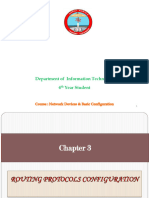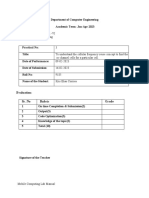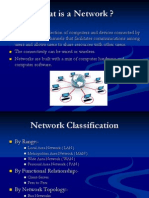0 ratings0% found this document useful (0 votes)
Um Olsr
Um Olsr
Uploaded by
Hansi WijesingheThis document provides an overview of the Optimized Link State Routing (OLSR) protocol and how to install the UM-OLSR implementation in NS2. It describes key aspects of OLSR including how it uses MultiPoint Relays (MPRs) to reduce flooding, the MPR selection algorithm, topology tables, and routing tables. It also lists the main files that make up the UM-OLSR implementation and provides instructions for downloading, compiling, and running an example simulation script.
Copyright:
© All Rights Reserved
Available Formats
Download as PPT, PDF, TXT or read online from Scribd
Download as ppt, pdf, or txt
Um Olsr
Um Olsr
Uploaded by
Hansi Wijesinghe0 ratings0% found this document useful (0 votes)
This document provides an overview of the Optimized Link State Routing (OLSR) protocol and how to install the UM-OLSR implementation in NS2. It describes key aspects of OLSR including how it uses MultiPoint Relays (MPRs) to reduce flooding, the MPR selection algorithm, topology tables, and routing tables. It also lists the main files that make up the UM-OLSR implementation and provides instructions for downloading, compiling, and running an example simulation script.
Original Description:
About OLSR
Original Title
UM-OLSR
Copyright
© © All Rights Reserved
Available Formats
PPT, PDF, TXT or read online from Scribd
Share this document
Did you find this document useful?
Is this content inappropriate?
This document provides an overview of the Optimized Link State Routing (OLSR) protocol and how to install the UM-OLSR implementation in NS2. It describes key aspects of OLSR including how it uses MultiPoint Relays (MPRs) to reduce flooding, the MPR selection algorithm, topology tables, and routing tables. It also lists the main files that make up the UM-OLSR implementation and provides instructions for downloading, compiling, and running an example simulation script.
Copyright:
© All Rights Reserved
Available Formats
Download as PPT, PDF, TXT or read online from Scribd
Download as ppt, pdf, or txt
0 ratings0% found this document useful (0 votes)
Um Olsr
Um Olsr
Uploaded by
Hansi WijesingheThis document provides an overview of the Optimized Link State Routing (OLSR) protocol and how to install the UM-OLSR implementation in NS2. It describes key aspects of OLSR including how it uses MultiPoint Relays (MPRs) to reduce flooding, the MPR selection algorithm, topology tables, and routing tables. It also lists the main files that make up the UM-OLSR implementation and provides instructions for downloading, compiling, and running an example simulation script.
Copyright:
© All Rights Reserved
Available Formats
Download as PPT, PDF, TXT or read online from Scribd
Download as ppt, pdf, or txt
You are on page 1/ 22
UM-OLSR
OLSR routing protocol in NS2
695430044
Outline
Brief overview of OLSR
MPR selection algorithm
UM-OLSR install
Example
UM-OLSR code
Classification
Table driven
Source-Initiated
On demand
DSDV
CGSR
OLSR
TBRPF
AODV DSR LMR
TORA
ABR
SSR
Ad Hoc Routing
Protocols
proactive
reactive
Optimized Link State Routing Protocol
Proactive & Table-driven
Link State Routing
Each node expands a spanning tree
Each node can obtain the whole network topology
Utilizes a technique to reduce message flooding
MultiPoint Relaying (MPR)
Optimized Link State Routing Protocol
Each node periodically floods
status of its links
Each node re-broadcasts link state
information received from its
neighbors
Each node keeps track of link state
information received from other
nodes
Each node uses above information
to determine next hope to each
destination
24 retransmissions to
diffuse a message up to 3
hops
Retransmission node
Optimized Link State Routing Protocol
Only selected neighbors (MultiPoint
Relays, MPRs) retransmit
messages
Select MPRs such that they cover
all 2hop neighbors
2-hop neighbors taken from
neighbors' HELLO messages
11 retransmission to
diffuse a message up to 3
hops
Retransmission node
- MPR
Optimized Link State Routing Protocol
Three main modules
Neighbor/link sensing
Provide topology information up to two hops
MPR selector information notification
(A select B as As MPR in HELLO message to B)
Optimized flooding/forwarding
MPR set to cover all the two hop neighbors
MPR selector set: set of nodes that select me as one of their
MPR set
OLSR-Messages from MPR selector set are to be forwarded
Link-State messaging and route calculation
Topology table
Route table
MPR selection
Each node select a set of MPR
Selectors
Who can be a MPR Selectors
of node N ?
one-hop neighbors of N
MPR set of Node N (Rules)
Set of MPRs is able to
transmit to all two-hop neighbors
Link between node and its
MPR is bidirectional.
D
N
B
M
X
Y
Z
A
Multipoint Relays (MPR)
Every node keeps a table of routes to all known
destination through its MPR nodes
Every node periodically broadcasts list of its MPR
Selectors (instead of the whole list of neighbors).
Upon receipt of MPR information each node recalculates
and updates routes to each known destination
MPR selection algorithm
Each point u has to select its set of MPR.
Goal :
Select in the 1-neighborhood of u (N
1
(u)) a set of nodes as
small as possible which covers the whole 2-neighborhood of
u(N
2
(u)).
Step 1: Select nodes of N
1
(u) which cover isolated points
of N
2
(u).
Step 2: Select among the nodes of N
1
(u) not selected at
the first step, the node which covers the highest
number of points of N
2
(u) and go on till every
points of N
2
(u) are covered.
MPR selection algorithm
First step: Select nodes in N1(u) which cover isolated points of
N2(u).
u
MPR selection algorithm
Second step : Consider in N1(u) only points which are not already
selected at the first step NPR1(u) and points in N2(u) which are not
covered by the NPR1(u) . While there exists points in N2(u) not
covered by the selected MPR, select in N2(u), the node which covers
the highest number of non-covered nodes in N2(u).
u
MPR selection algorithm
FinalMPRs
u
Installation
Download UM-OLSR 0.8.8 from
http://masimum.dif.um.es/?Software:UM-OLSR
Ns2.272.282.29 / UM-OLSR 0.8.70.8.8
Copy um-olsr-0.8.8.tgz to ns-allinone-2.29/ns-2.29/
$ cd ns-allinone-2.29/ns-2.29/
$ tar zxvf um-olsr-0.8.8.tgz
$ ln -s ./um-olsr-0.8.8 ./olsr
$ patch -p1 < olsr/um-olsr_ns-2.29_v0.8.8.patch
$ ./configure
$ make
Example
Download olsr_example.tcl from
http://masimum.dif.um.es/um-olsr/olsr_example.tcl
OLSR
Hello message one hop for
Two hop topology information
MPRs
Transmit two hop top topology information
By MPRs
TC message
Complete Topology Information
Shortest Path Tree calculation (Dijkstra)
Routing table build
TC message
TC Topology control message:
Sent periodically. Message might not be sent if there are
no updates and sent earlier if there are updates
Contains:
MPR Selector Table
Sequence number
Each node maintains a Topology Table based on TC
messages
Routing Tables are calculated based on Topology tables
Topology Table
Destination
address
Destinations
MPR
MPR Selector
sequence
number
Holding time
MPR Selector in
the received TC
message
Last-hop node to the destination.
Originator of TC message
TC message
Upon receipt of TC message:
If there exist some entry to the same destination with
higher Sequence Number, the TC message is ignored
If there exist some entry to the same destination with lower
Sequence Number, the topology entry is removed and the
new one is recorded
If the entry is the same as in TC message, the holding time
of this entry is refreshed
Routing Table
Each node maintains a routing table to all known
destinations in the network
Routing table is calculated from Topological Table, taking
the connected pairs
Routing table:
Destination address
Next Hop address
Distance
Routing Table is recalculated after every change in
neighborhood table or in topological table
UM-OLSR File List (Header)
OLSR.h
header file for OLSR agent and related classes
OLSR_pkt.h
contains all declarations of OLSR packets and messages
OLSR_printer.h
includes all printing functions related to OLSR
OLSR_repositories.h
defined all data structures needed by an OLSR node
OLSR_rtable.h
header file for routing table's related stuff
OLSR_state.h
declares and defines internal state of an OLSR node
UM-OLSR File List
OLSR.cc
Implementation of OLSR agent and related classes
OLSR_printer.cc
Printing functions used for debugging and tracing are implemented
in this file
OLSR_rtable.cc
Implementation of our routing table
OLSR_state.cc
Implementation of all functions needed for manipulating the
internal state of an OLSR node
You might also like
- IP Routing Protocols All-in-one: OSPF EIGRP IS-IS BGP Hands-on LabsFrom EverandIP Routing Protocols All-in-one: OSPF EIGRP IS-IS BGP Hands-on LabsNo ratings yet
- Digital Spectral Analysis MATLAB® Software User GuideFrom EverandDigital Spectral Analysis MATLAB® Software User GuideNo ratings yet
- Ad Hoc Networks: Cholatip Yawut Faculty of Information Technology King Mongkut's University of Technology North BangkokNo ratings yetAd Hoc Networks: Cholatip Yawut Faculty of Information Technology King Mongkut's University of Technology North Bangkok56 pages
- Ad Hoc Networks: Cholatip Yawut Faculty of Information Technology King Mongkut's University of Technology North BangkokNo ratings yetAd Hoc Networks: Cholatip Yawut Faculty of Information Technology King Mongkut's University of Technology North Bangkok56 pages
- Routing Protocols (RIP, OSPF, and BGP) : Mi-Jung Choi Dept. of Computer Science and Engineering Mjchoi@postech - Ac.krNo ratings yetRouting Protocols (RIP, OSPF, and BGP) : Mi-Jung Choi Dept. of Computer Science and Engineering Mjchoi@postech - Ac.kr86 pages
- A Result Based Comparison of DSDV, AODV and DSR Routing ProtocolsNo ratings yetA Result Based Comparison of DSDV, AODV and DSR Routing Protocols4 pages
- Performance Comparison of Ad Hoc Routing Protocols Over IEEE 802.11 DCF and TDMA MAC Layer ProtocolsNo ratings yetPerformance Comparison of Ad Hoc Routing Protocols Over IEEE 802.11 DCF and TDMA MAC Layer Protocols5 pages
- Performance Evaluation of Energy Consumption of Ad Hoc Routing ProtocolsNo ratings yetPerformance Evaluation of Energy Consumption of Ad Hoc Routing Protocols8 pages
- Functions of Network Layer Routing TableNo ratings yetFunctions of Network Layer Routing Table4 pages
- 2011-11-30 Power and Mobility Aware Routing in Wireless Ad Hoc NetworksNo ratings yet2011-11-30 Power and Mobility Aware Routing in Wireless Ad Hoc Networks28 pages
- What Is The Diffrence About RSRP-SINR-RSRQ-RSSI?No ratings yetWhat Is The Diffrence About RSRP-SINR-RSRQ-RSSI?10 pages
- Rendezvous in OFDMA-CRN Based On Primary User Activity Using Frequency Hopping TechniqueNo ratings yetRendezvous in OFDMA-CRN Based On Primary User Activity Using Frequency Hopping Technique14 pages
- ZXR10-BC-En-OSPF Protocol Principle and Configuration (OSPF Protocol Principle) - 1 51-201309No ratings yetZXR10-BC-En-OSPF Protocol Principle and Configuration (OSPF Protocol Principle) - 1 51-20130951 pages
- Ad-Hoc Routing Protocol How Does It WorkNo ratings yetAd-Hoc Routing Protocol How Does It Work48 pages
- Performance Analysis of Multiuser MIMO Systems With Zero Forcing ReceiversNo ratings yetPerformance Analysis of Multiuser MIMO Systems With Zero Forcing Receivers5 pages
- Data and Computer Communications: - Routing in Switched NetworksNo ratings yetData and Computer Communications: - Routing in Switched Networks32 pages
- Plagiarism Checker X Originality: Similarity Found: 22%No ratings yetPlagiarism Checker X Originality: Similarity Found: 22%9 pages
- A Novel Channel Estimation Algorithm For 3GPP LTE Downlink System Using Joint Time-Frequency Two-Dimensional Iterative Wiener FilterNo ratings yetA Novel Channel Estimation Algorithm For 3GPP LTE Downlink System Using Joint Time-Frequency Two-Dimensional Iterative Wiener Filter4 pages
- ROUTING INFORMATION PROTOCOL: RIP DYNAMIC ROUTING LAB CONFIGURATIONFrom EverandROUTING INFORMATION PROTOCOL: RIP DYNAMIC ROUTING LAB CONFIGURATIONNo ratings yet
- LEARN MPLS FROM SCRATCH PART-B: A Beginners guide to next level of networkingFrom EverandLEARN MPLS FROM SCRATCH PART-B: A Beginners guide to next level of networkingNo ratings yet
- Eaton Network Card Ms User Guide ManualNo ratings yetEaton Network Card Ms User Guide Manual142 pages
- Group04 IEEE Paper - An Android Based Real-Time Fitness Tracker and Diet SuggesterNo ratings yetGroup04 IEEE Paper - An Android Based Real-Time Fitness Tracker and Diet Suggester7 pages
- C# Melsec MxComponent V4 #3 Coding (Sending and Receiving in Double Word Units)No ratings yetC# Melsec MxComponent V4 #3 Coding (Sending and Receiving in Double Word Units)28 pages
- Timetable for Mid-Term Makeup ExaminationNo ratings yetTimetable for Mid-Term Makeup Examination168 pages
- Thanks: With More Than 1000 Students/ Professors, Subject Experts and Editors Contributing To It Every Day0% (1)Thanks: With More Than 1000 Students/ Professors, Subject Experts and Editors Contributing To It Every Day46 pages
- Upload 5 Documents To Download: 46028332127-Annayya-02No ratings yetUpload 5 Documents To Download: 46028332127-Annayya-021 page
- Emergence of AI Based Business Models WhitepaperNo ratings yetEmergence of AI Based Business Models Whitepaper14 pages
- Abap Project Demo On Wednesday 11.30 Am: BASICS (1 Day)No ratings yetAbap Project Demo On Wednesday 11.30 Am: BASICS (1 Day)2 pages
- GET Bank A/Cs: Moinabad JB Institue of Engineering and Technology Yenkapally Moinabad-14185No ratings yetGET Bank A/Cs: Moinabad JB Institue of Engineering and Technology Yenkapally Moinabad-14185148 pages
- List Dated 07/20/2011 Have Been Corrected.", The Third Printing Is Identified As "3/12", and TheNo ratings yetList Dated 07/20/2011 Have Been Corrected.", The Third Printing Is Identified As "3/12", and The8 pages
- Technology and Independent Distribution in The European Travel Industry 2010100% (1)Technology and Independent Distribution in The European Travel Industry 201064 pages
- Appliance Watts Appliance Watts Appliance Watts: Kitchen Living Room ToolsNo ratings yetAppliance Watts Appliance Watts Appliance Watts: Kitchen Living Room Tools2 pages
- IP Routing Protocols All-in-one: OSPF EIGRP IS-IS BGP Hands-on LabsFrom EverandIP Routing Protocols All-in-one: OSPF EIGRP IS-IS BGP Hands-on Labs
- Digital Spectral Analysis MATLAB® Software User GuideFrom EverandDigital Spectral Analysis MATLAB® Software User Guide
- Ad Hoc Networks: Cholatip Yawut Faculty of Information Technology King Mongkut's University of Technology North BangkokAd Hoc Networks: Cholatip Yawut Faculty of Information Technology King Mongkut's University of Technology North Bangkok
- Ad Hoc Networks: Cholatip Yawut Faculty of Information Technology King Mongkut's University of Technology North BangkokAd Hoc Networks: Cholatip Yawut Faculty of Information Technology King Mongkut's University of Technology North Bangkok
- Routing Protocols (RIP, OSPF, and BGP) : Mi-Jung Choi Dept. of Computer Science and Engineering Mjchoi@postech - Ac.krRouting Protocols (RIP, OSPF, and BGP) : Mi-Jung Choi Dept. of Computer Science and Engineering Mjchoi@postech - Ac.kr
- A Result Based Comparison of DSDV, AODV and DSR Routing ProtocolsA Result Based Comparison of DSDV, AODV and DSR Routing Protocols
- Performance Comparison of Ad Hoc Routing Protocols Over IEEE 802.11 DCF and TDMA MAC Layer ProtocolsPerformance Comparison of Ad Hoc Routing Protocols Over IEEE 802.11 DCF and TDMA MAC Layer Protocols
- Performance Evaluation of Energy Consumption of Ad Hoc Routing ProtocolsPerformance Evaluation of Energy Consumption of Ad Hoc Routing Protocols
- 2011-11-30 Power and Mobility Aware Routing in Wireless Ad Hoc Networks2011-11-30 Power and Mobility Aware Routing in Wireless Ad Hoc Networks
- Rendezvous in OFDMA-CRN Based On Primary User Activity Using Frequency Hopping TechniqueRendezvous in OFDMA-CRN Based On Primary User Activity Using Frequency Hopping Technique
- ZXR10-BC-En-OSPF Protocol Principle and Configuration (OSPF Protocol Principle) - 1 51-201309ZXR10-BC-En-OSPF Protocol Principle and Configuration (OSPF Protocol Principle) - 1 51-201309
- Performance Analysis of Multiuser MIMO Systems With Zero Forcing ReceiversPerformance Analysis of Multiuser MIMO Systems With Zero Forcing Receivers
- Data and Computer Communications: - Routing in Switched NetworksData and Computer Communications: - Routing in Switched Networks
- Plagiarism Checker X Originality: Similarity Found: 22%Plagiarism Checker X Originality: Similarity Found: 22%
- A Novel Channel Estimation Algorithm For 3GPP LTE Downlink System Using Joint Time-Frequency Two-Dimensional Iterative Wiener FilterA Novel Channel Estimation Algorithm For 3GPP LTE Downlink System Using Joint Time-Frequency Two-Dimensional Iterative Wiener Filter
- ROUTING INFORMATION PROTOCOL: RIP DYNAMIC ROUTING LAB CONFIGURATIONFrom EverandROUTING INFORMATION PROTOCOL: RIP DYNAMIC ROUTING LAB CONFIGURATION
- LEARN MPLS FROM SCRATCH PART-B: A Beginners guide to next level of networkingFrom EverandLEARN MPLS FROM SCRATCH PART-B: A Beginners guide to next level of networking
- IP MULTICAST ROUTING Part -3: Use of multicast routing.From EverandIP MULTICAST ROUTING Part -3: Use of multicast routing.
- Group04 IEEE Paper - An Android Based Real-Time Fitness Tracker and Diet SuggesterGroup04 IEEE Paper - An Android Based Real-Time Fitness Tracker and Diet Suggester
- C# Melsec MxComponent V4 #3 Coding (Sending and Receiving in Double Word Units)C# Melsec MxComponent V4 #3 Coding (Sending and Receiving in Double Word Units)
- Thanks: With More Than 1000 Students/ Professors, Subject Experts and Editors Contributing To It Every DayThanks: With More Than 1000 Students/ Professors, Subject Experts and Editors Contributing To It Every Day
- Upload 5 Documents To Download: 46028332127-Annayya-02Upload 5 Documents To Download: 46028332127-Annayya-02
- Abap Project Demo On Wednesday 11.30 Am: BASICS (1 Day)Abap Project Demo On Wednesday 11.30 Am: BASICS (1 Day)
- GET Bank A/Cs: Moinabad JB Institue of Engineering and Technology Yenkapally Moinabad-14185GET Bank A/Cs: Moinabad JB Institue of Engineering and Technology Yenkapally Moinabad-14185
- List Dated 07/20/2011 Have Been Corrected.", The Third Printing Is Identified As "3/12", and TheList Dated 07/20/2011 Have Been Corrected.", The Third Printing Is Identified As "3/12", and The
- Technology and Independent Distribution in The European Travel Industry 2010Technology and Independent Distribution in The European Travel Industry 2010
- Appliance Watts Appliance Watts Appliance Watts: Kitchen Living Room ToolsAppliance Watts Appliance Watts Appliance Watts: Kitchen Living Room Tools

























































































